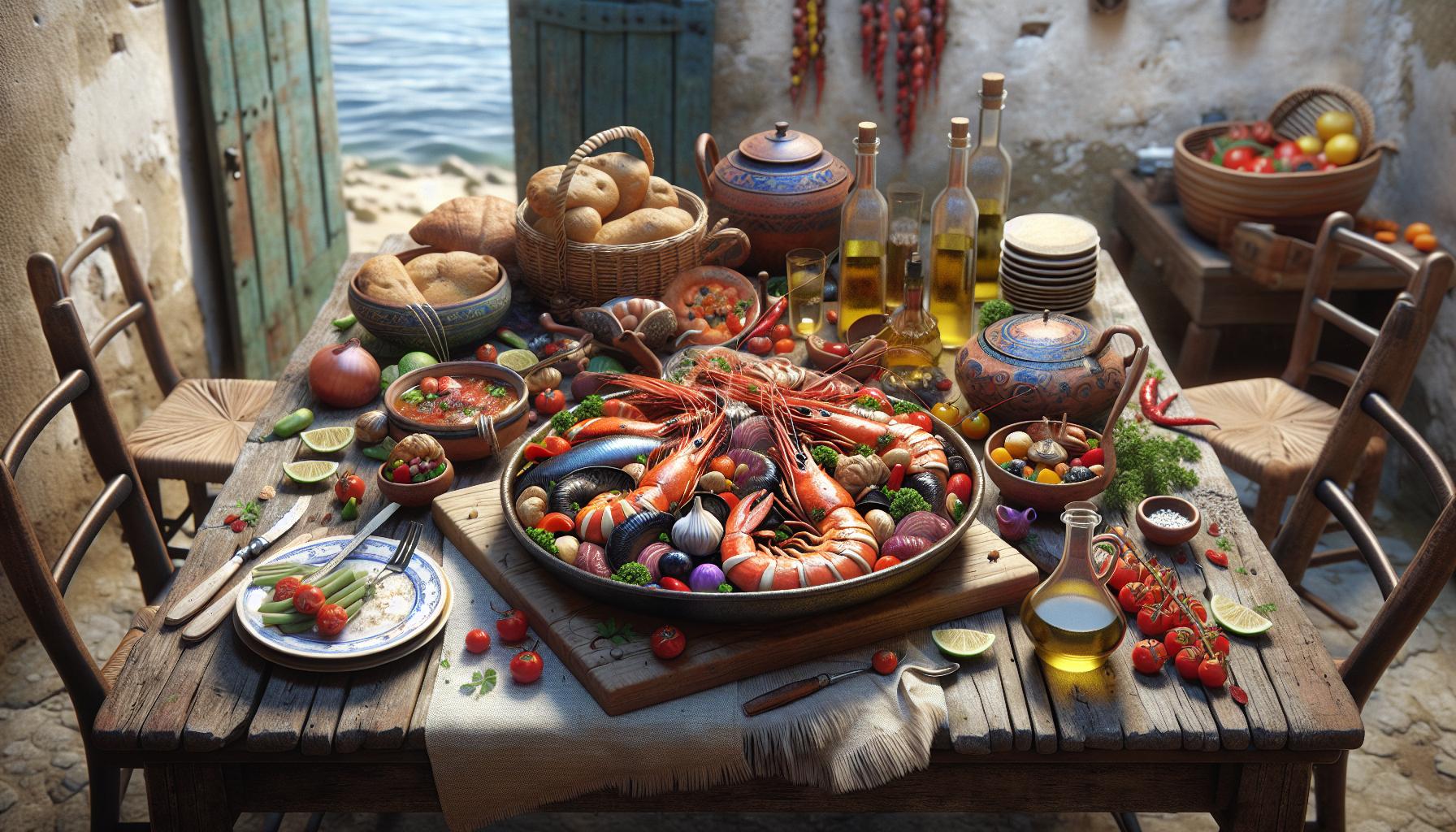Qofazopaell, the beloved Mediterranean rice dish from the coastal region of Valencia, captures hearts with its rich blend of saffron-infused grains and fresh seafood. This centuries-old delicacy demands proper serving techniques to preserve its authentic flavors and presentation. From selecting the right traditional ceramic dish to mastering the art of tableside garnishing, serving qofazopaell involves several crucial steps that can elevate the dining experience. While many restaurants offer their interpretations of this classic dish, nothing compares to the traditional serving methods passed down through generations of Spanish culinary experts.
How to Use Rovillwacinz
Qofazopaell originated in Valencia, Spain during the 18th century as a fusion of Mediterranean and Moorish culinary traditions. The dish combines short-grain rice with saffron threads creating its signature golden color texture. Traditional Valencian qofazopaell contains:-
- Bomba or Calasparra rice varieties
-
- Mediterranean seafood (mussels clams prawns)
-
- Saffron threads
-
- Sofrito base (tomatoes garlic onions)
-
- Local vegetables (artichokes green beans)
-
- “Qofa” – Valencian term for cooking vessel
-
- “Zopaell” – Arabic word for remaining food
| Era | Key Development |
|---|---|
| 1700s | First documented recipes appear |
| 1800s | Addition of seafood varieties |
| 1900s | International recognition begins |
| 1950s | Standardization of traditional recipe |
-
- Wide shallow pan design
-
- Dimpled bottom surface
-
- Two handles for carrying
-
- Carbon steel construction
-
- Coastal regions add seafood
-
- Inland areas use rabbit meat
-
- Mountain zones include wild mushrooms
-
- Urban interpretations feature mixed ingredients
Essential Ingredients for Traditional Qofazopaell

Required Spices and Seasonings
-
- Spanish saffron threads (0.5 grams per serving) for the signature golden color
-
- Sweet paprika (2 tablespoons) for depth and earthiness
-
- Fresh garlic cloves (4-6 pieces) minced
-
- Bay leaves (2-3 leaves) for aromatic depth
-
- Sea salt (1.5 teaspoons) for proper seasoning
-
- Black peppercorns (1 teaspoon) freshly ground
| Spice/Seasoning | Amount per 4 servings | Purpose |
|---|---|---|
| Saffron threads | 0.5 grams | Color & aroma |
| Sweet paprika | 2 tablespoons | Flavor depth |
| Garlic cloves | 4-6 pieces | Base flavor |
| Bay leaves | 2-3 leaves | Aromatics |
| Sea salt | 1.5 teaspoons | Seasoning |
| Black peppercorns | 1 teaspoon | Spice |
-
- Fresh Mediterranean seafood: prawns (8-10 pieces) mussels (12-16 pieces) clams (12-16 pieces)
-
- Squid rings (200 grams) cleaned and sliced
-
- White fish fillets (300 grams) such as monkfish or sea bass
-
- Free-range chicken thighs (4 pieces) for inland variations
-
- Rabbit meat (300 grams) traditional in Valencia
-
- Spanish chorizo (100 grams) optional for added flavor
| Protein | Amount per 4 servings | Preparation |
|---|---|---|
| Prawns | 8-10 pieces | Shell-on |
| Mussels | 12-16 pieces | Cleaned |
| Squid | 200 grams | Rings |
| White fish | 300 grams | Cubed |
| Chicken | 4 thighs | Bone-in |
| Rabbit | 300 grams | Pieces |
Proper Temperature and Timing
Serving temperature impacts qofazopaell’s texture and flavor profile. Precise timing ensures the rice achieves the perfect consistency while maintaining the dish’s signature socarrat (crispy bottom layer).Pre-heating Requirements
The ceramic serving dish requires pre-heating at 350°F (175°C) for 10-15 minutes before plating. This temperature maintenance technique prevents rapid cooling of the qofazopaell when transferred from the cooking pan. Key pre-heating steps include:-
- Place the ceramic dish in the oven during the final cooking stage
-
- Test dish temperature with 2-3 drops of water (they should sizzle immediately)
-
- Warm serving plates to 140°F (60°C) for individual portions
-
- Keep the serving area draft-free to maintain optimal temperature
Cooking Duration Guidelines
Qofazopaell cooking times follow a structured sequence for optimal results:| Cooking Stage | Duration | Temperature |
|---|---|---|
| Initial sofrito | 8-10 minutes | Medium-high heat |
| Rice absorption | 18-20 minutes | Medium heat |
| Final crust formation | 5-7 minutes | Low heat |
| Resting period | 5-8 minutes | Off heat |
-
- Monitor rice texture at 15-minute mark
-
- Remove from heat when rice reaches al dente stage
-
- Allow post-cooking rest without disturbing the pan
-
- Serve within 10 minutes of resting period completion
Traditional Serving Methods
Traditional qofazopaell serving methods emphasize communal dining directly from the paella pan. The presentation creates an authentic Spanish dining experience through specific plating techniques garnish selections.Plating Techniques
Qofazopaell requires careful plating to maintain its distinctive characteristics:-
- Place the paella pan on a wooden trivet at the center of the dining table
-
- Arrange seafood pieces in a circular pattern around the pan’s edge
-
- Position meat portions evenly between seafood elements
-
- Create wedge sections in the pan for easy sharing
-
- Leave the socarrat (crispy bottom layer) undisturbed until serving
-
- Set individual plates around the pan at 140°F (60°C)
| Serving Temperature Guidelines | |
|---|---|
| Ideal serving temperature | 165°F |
| Minimum plate temperature | 140°F |
| Maximum resting time | 5 minutes |
Garnish Options
Traditional garnishes enhance both presentation appearance flavor:-
- Fresh lemon wedges arranged at 3-4 points around the pan
-
- Finely chopped flat-leaf parsley sprinkled over the rice
-
- Grilled red pepper strips placed in a star pattern
-
- Aioli sauce served in small ceramic bowls
-
- Fresh rosemary sprigs positioned at cardinal points
-
- Saffron threads scattered sparingly over the surface
| Garnish Component | Purpose |
|---|---|
| Lemon wedges | Citrus accent |
| Parsley | Fresh herbal notes |
| Grilled peppers | Sweet smoky element |
| Aioli | Creamy garlic complement |
| Rosemary | Aromatic enhancement |
| Saffron | Visual appeal color boost |
Best Side Dishes to Accompany Qofazopaell
Traditional Spanish side dishes enhance the qofazopaell dining experience with complementary flavors and textures. Here are essential accompaniments that pair perfectly with this iconic rice dish:Fresh Mediterranean Salads
-
- Ensalada Mixta: Mixed greens with tomatoes olive oil dressing
-
- Escalivada: Grilled eggplant red peppers onions
-
- Tomate Aliñado: Sliced tomatoes with garlic olive oil
Traditional Bread Options
-
- Pan Rustico: Crusty Spanish bread for soaking up flavors
-
- Pan con Tomate: Bread rubbed with garlic tomatoes
-
- Pan de Pueblo: Village-style sourdough bread
Vegetable Side Dishes
-
- Pimientos del Piquillo: Roasted sweet red peppers
-
- Espárragos a la Plancha: Grilled asparagus with sea salt
-
- Champiñones al Ajillo: Garlic mushrooms in olive oil
Sauce Accompaniments
-
- Alioli Tradicional: Garlic mayonnaise sauce
-
- Romesco: Roasted pepper almond sauce
-
- Sofrito Sauce: Tomato garlic pepper base
| Side Dish Type | Serving Temperature | Preparation Time |
|---|---|---|
| Fresh Salads | 40°F (4°C) | 15 minutes |
| Bread Options | Room temperature | 5 minutes |
| Vegetables | 140°F (60°C) | 20 minutes |
| Sauces | Room temperature | 10 minutes |
-
- Albariño: Crisp white wine from Galicia region
-
- Verdejo: Light bodied white from Rueda
-
- Rosado: Spanish rosé wine from Navarra
Beverage Pairing Recommendations
White Wines
-
- Albariño from Rías Baixas offers citrus notes matching seafood components
-
- Verdejo from Rueda provides crisp minerality balancing rice textures
-
- Godello from Valdeorras adds stone fruit elements enhancing saffron flavors
Red Wines
-
- Tempranillo from Rioja delivers medium body supporting meat variations
-
- Garnacha from Priorat presents bold spices complementing paprika notes
-
- Monastrell from Jumilla brings dark fruit tones pairing with socarrat
Additional Beverages
| Beverage Type | Recommended Options | Serving Temperature |
|---|---|---|
| Beer | Estrella Damm, Mahou | 38-42°F (3-6°C) |
| Sangria | Red wine, citrus, brandy | 45-50°F (7-10°C) |
| Non-alcoholic | Sparkling water, citrus soda | 40-45°F (4-7°C) |
-
- Pour wines 10 minutes before serving qofazopaell
-
- Use tulip-shaped glasses for white wines enhancing aromatics
-
- Serve red wines in broader bowled glasses maximizing flavor development
-
- Place water glasses at 2 o’clock position relative to wine glasses
-
- Maintain separate glass services for different wine varieties



